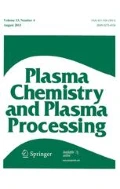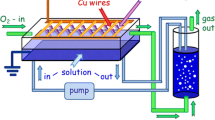Abstract
A pilot-scale pulse corona induced plasma chemical process (PPCP) reactor for controlling gas-phase dioxins and NO x simultaneously is installed in a garbage incineration plant. The flow rate of the sampled flue gas is 5,000 Nm3/h (N: standard state) in maximum at the PPCP reactor, which consists of 22 wire-cylinder electrodes and is energized by a 50 kW nanosecond pulse high voltage generator. With an applied plasma energy density of 2.9–6.1 Wh/Nm3, the decomposition efficiency for dioxins is 75–84% based on TEQ (toxic equivalents); the conversion efficiency of NO to NO2 is ~93% at maximum. The flue gas treated by the PPCP reactor is introduced at a rate of 50 Nm3/h to a wet-type chemical reactor, which uses an aqueous solution of sodium sulfite (Na2SO3). More than 90% of NO x is reduced to nitrogen, with negligible byproducts such as NO2 − or NO3 − ions left in the solution.












Similar content being viewed by others
References
Kim HH, Yamamoto I, Takashima K, Katsura S, Mizuno A (2000) Incinerator flue gas cleaning using wet-type electrostatic precipitator. J Chem Eng Jap 33(4):669–674
Weber R, Sakurai T, Hagenmaier H (1999) Low temperature decomposition of PCDD/PCDF, chlorobenzenes and PAHs by TiO2-based V2O5–WO3 catalysts. Appl Catal B 20(4):249–256
Paur HR, Baumann W, Mätzing H, Jay K (1998) Electron beam induced decomposition of chlorinated aromatic compounds in waste incinerator offgas. Radiat Phys Chem 52(1–6):355–359
Kim HH (2004) Nonthermal plasma processing for air-pollution control: a historical review, current issues and future prospects. Plasma Process Polym 1(2):91–110
Penetrante MB (1993) Non-thermal plasma reactors for treatment of NO x and other hazardous gas emission. Task 1. 1 Report for CRADAT, #336-92-1-C, October 1993
Penetrante MB (1993) Plasma-chemistry and power consumption in non-thermal plasma DeNO x , nonthermal plasma techniques for pollution control. NATO ASI Ser A 34:65–89
Matsui Y, Sawadan J, Koyamoto I, Takashima K, Katsura S, Mizuno A (2005) After-treatment of NO x using combination of non-thermal plasma and oxidative catalyst by novel impregnation. J Adv Oxid Technol 8(2):44–50
Oda T, Kato T, Takahashi T, Shimizu K (1998) Nitric oxide decomposition in air by using non-thermal plasma processing with additives and catalyst. IEEE Trans Ind Appl 34(2):268–272
Kim HH, Tsunoda K, Katsura S, Mizuno A (1997) Novel plasma reactor for NO x control using photocatalyst and hydrogen peroxide injection. In: Proceedings of IEEE-IAS annual meeting, vol 3. New Orleans, pp 1937–1941
Kim HH, Tsunoda K, Shimizu K, Tanaka S, Yamamoto T (1999) Experimental approach to enhance of non-thermal plasma process in flue gas cleaning. J Adv Oxid Technol 4(3):347–351
Hammer T, Kappes T, Baldauf M (2004) Plasma catalytic hybrid processes: gas discharge initiation and plasma activation of catalytic processes. Catal Today 89(1–2):5–14
Kwak JH, Szanyi J, Peden CHF (2004) Non-thermal plasma-assisted NO x reduction over alkali and alkaline earth ion exchanged Y, FAU zeolites. Catal Today 89(1–2):135–141
Tonkyn RG, Barlow SE, Hoard JW (2003) Reduction of NO x in synthetic diesel exhaust via two-step plasma-catalysis treatment. Appl Cat B 40(3):207–217
Chae JO (2003) Non-thermal plasma for diesel exhaust treatment. J Electrostat 57(3–4):251–262
Yoon S, Panov AG, Tonkyn RG, Ebeling AC, Barlow SE, Balmer ML (2002) An examination of the role of plasma treatment for lean NO x reduction over sodium zeolite Y and gamma alumina part 2 formation of nitrogen. Catal Today 72(3–4):251–257
Yang CL, Chen L (2000) Oxidation of nitric oxide in a two-stage chemical scrubber using dc corona discharge. J Hazard Mater B80(1–3):135–146
Yang CL, Beltran M, Kravets Z, Yamamoto T (1998) Corona-induced chemical scrubber for the control of NO x emissions. Environ Prog 17(3):183–189
Chen L, Lin JW, Yang CL (2002) Absorption of NO2 in a packed tower with Na2SO3 aqueous solution. Environ Prog 21(4):225–230
Mok YS, Lee HJ (2006) Removal of sulfur dioxide and nitrogen oxides by using ozone injection and absorption-reduction technique. Fuel Process Technol 87(7):591–597
Yamamoto T, Okubo M, Nagaoka T, Hayakawa K (2000) Simultaneous removal of NO x , SO x , and CO2 at elevated temperature using a plasma-chemical hybrid process. IEEE Trans Ind Appl 38(5):1168–1173
Yamamoto T, Okubo M, Hayakawa K, Kitamura K (2001) Toward ideal NO x control technology using plasma-chemical hybrid process. IEEE Trans Ind Appl 37(5):1492–1498
Kuroki T, Takahashi M, Okubo M, Yamamoto T (2002) Single-stage plasma-chemical process for particulates, NO x and SO x simultaneous removal. IEEE Trans Ind Appl 38(5):1204–1209
Kuroki T, Fujishima H, Otsuka K, Ito T, Okubo M, Yamamoto T, Yoshida K (2008) Continuous operation of commercial-scale plasma-chemical aftertreatment system of smoke tube boiler emission with oxidation reduction potential and pH control. Thin Solid Films 516(19):6704–6709
Masuda S, Nakao H (1990) Control of NO x by positive and negative pulsed corona discharges. IEEE Trans Ind Appl 26(2):374–383
Masuda S, Hosokawa S, Tu X, Wang Z (1995) Novel plasma chemical technologies—PPCP and SPCP for control of gaseous pollutants and air toxics. J Electrostat 34(4):415–438
Tamaki A, Hosokawa S (1996) Reduction of chemical pollutants in the exhaust gas of the municipal waste incinerator by PPCP. In: Proceedings of 6th international conference on electrostatic precipitation. Budapest, pp 544–549
Ministry of the Environment, the law regarding waste material treatment and cleaning, http://www.env.go.jp/hourei/index.html
Park KS, Kim DI, Lee HS, Chun KM, Chun BH (2001) Effect of various hydrocarbons on the plasma DeNO x process. SAE paper, 2001-01-3515
Acknowledgments
The authors sincerely thank Mr. K. Kitaura and K. Hayakawa (former graduate students of Osaka Prefecture University) for their support in the experiments. This study is partially supported by Grant-in-Aid of the Japan Society of Promotion of Science.
Author information
Authors and Affiliations
Corresponding author
Rights and permissions
About this article
Cite this article
Yoshida, K., Yamamoto, T., Kuroki, T. et al. Pilot-Scale Experiment for Simultaneous Dioxin and NO x Removal from Garbage Incinerator Emissions Using the Pulse Corona Induced Plasma Chemical Process. Plasma Chem Plasma Process 29, 373–386 (2009). https://doi.org/10.1007/s11090-009-9184-0
Received:
Revised:
Accepted:
Published:
Issue Date:
DOI: https://doi.org/10.1007/s11090-009-9184-0




